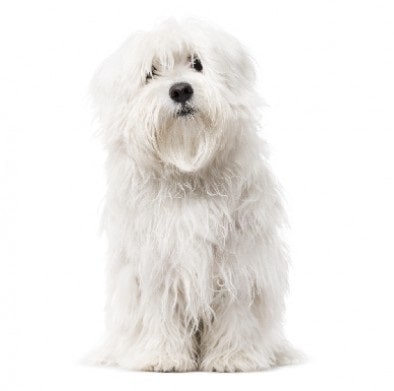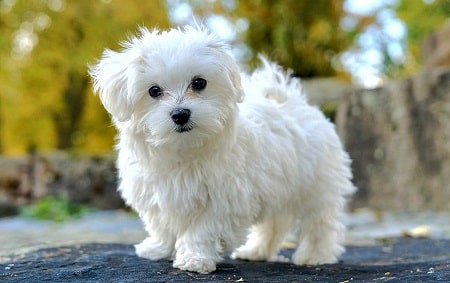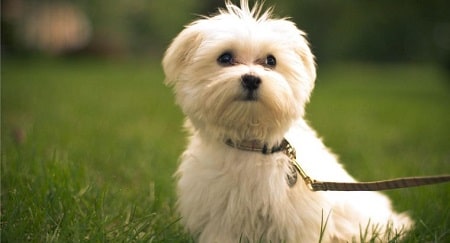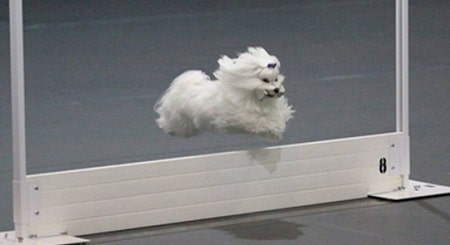Gentle but fearless, Maltese is known for his glamorous white coat. The shoe-button eyes are filled with love to give. They are friendly and very charming. These perfect toy companions are an epitome of elegance and perfection. Their haughty looks may be deceiving as they love nothing more than sending time with their family.
In the past, they have been given many names like Melitae Dog,” “Ye Ancient Dogge of Malta,” the “Roman Ladies Dog,” “The Comforter,” the “Spaniel Gentle,” the “Bichon,” the “Maltese Lion Dog,” and the “Maltese Terrier. However, now they are only known as the Maltese.
Maltese Breed Overview

| Group: | Toy |
| Size: | Tiny (4-7 pounds) |
| Lifespan: | 15-18 years |
| Best Suited For: | Families |
| Temperament: | Gently, Playful, Charming |
| Exercise Needs: | Moderate |
| Drooling Potential: | Low |
| Grooming Needs: | Moderate |
| Similar Breeds: | Shih Tzu, Yorkshire Terrier, Poodle |
1. Basic Features

The main job of this little pooch has always been being a companion. They have round little head with a button nose and little brown eyes. They have a white long coat and lack an undercoat. The coat does not shed a lot and is sometimes trimmed. As the coat doesn’t shed due to the lack of an undercoat, they are often recommended for people with allergies.
They are not only great companions but make great therapy dogs as well. They have been competitors in dog sports such as agility, obedience, rally, and tracking.
2. Maltese Origin
Maltese have a long history. These dogs are known to be since ancient times. They have been mentioned in the ancient history of Greece, Rome, and Egypt by artists, poets, and writers. Even Aristotle has mentioned the Maltese in his work.
The Greek erected tombs of their Maltese. They have been believed to cure diseases in ancient Europe and were hence placed on the pillow of the diseased. This gives them the name “The Comforter”.
In the Roman Empire, these dogs were considered a fashion symbol. A lady was never considered fully dressed without a “Roman Ladies’ Dog”
Maltese was even considered the favorite of the Royalties including Queen Elizabeth I, Mary Queen of Scots, and Queen Victoria.
It was in China that the breed was kept from extinction during Europe’s dark ages. The Maltese were not known in the US until the 1970s. Since then the breed has only become more popular and loved.
3. The Personality of Maltese

Maltese is a lively, vigorous dog who loves to spend time with his owners. This pooches are companion dogs and are very playful.
They generally prefer closed spaces. They like smaller places and is very active within a house. Hence, they do well in apartment living.
These dogs like making friends of all ages. As they are so people oriented, they respond well to training.
4. Maltese Behavior
Maltese are loving and affectionate. They love their family and want to be with them all the time. However, they may be snappish with younger children. It is important to supervise them while playing.
Early socialization is also recommended especially with children. They also tend to suffer from separation anxiety. Introducing them to new places and people while still young would help your pup polish his social skills.
It is difficult to predict the temperament of a puppy. One good way is to meet at least one of his parent. These small dogs tend to have a similar personality and temperament to their parents. However, social factors also contribute to the behavior of a Maltese.
5. Exercise Requirements
Maltese are full of energy and requires some exercise to keep fit. They have moderate exercise needs and a walk daily with their owner or some playing around the house would suffice the needs.
Since they remain very active indoors, they don’t require a great deal of exercise to keep them in shape. You should at least wait until your puppy is 8 months old before taking him to long walks or engaging him to vigorous exercise. Their bones are still developing till that age.
They also find it difficult to survive in extreme hot or cold weather.
6. Diet Needs
For a Maltese, a daily half cup of high-quality dry food, divided into two meals is recommended. It is important to keep your dog from getting fat by measuring his food and feeding him twice a day instead of leaving food out all the time.
Treats can be used while training but too many of them cause obesity in your dog.
Eating problems may occur due to various reasons. They have a very sensitive digestive system and may be picky eaters. Teeth or gum problems in Maltese may also cause eating problems.
7. Trainability

Being intelligent dogs, Maltese respond really well to training. They are very talented and excel in dog sports as well. They can be stubborn and very determined but are easy to train with positive training methods.
Treats can be used while training. Early obedience classes are important to avoid stubbornness. It is recommended to take your pooch to public parks and places for early socialization. The more your dog is around different people, places and their dogs, the more well behaved he will grow up to be.
8. Common Health Problems
Maltese is generally considered a healthy dog breed with very rare health conditions. Most of the small dog breeds have health problems related to their size, some of them may be genetic while some acquired. Tiny Maltese puppies are fragile and may have problems keeping their blood sugar levels up.
Also, they are prone to a congenital liver defect, known as a “portosystemic shunt,” according to a 2003 report published in the Journal of the American Veterinary Medical Association.
Dogs that have Portosystemic shunt may require expensive surgery to survive.
Cardiac exam and Patella examination are recommended for them.
9. Who should adopt a Maltese
Maltese are great dogs and are very compassionate. They’re great with families and love sticking around them. However, they may be a little snappy around children.
They are recommended for families with older children.
As Maltese do well in smaller spaces, they will make great pets if you’re living in an apartment or a smaller living space and want to adopt one cute, intelligent pooch!
